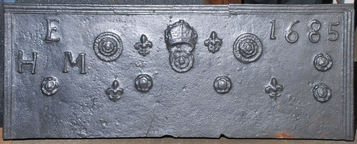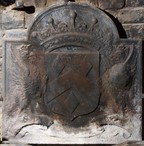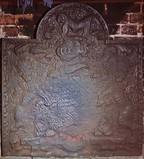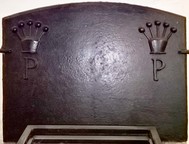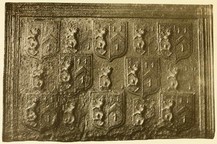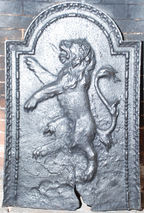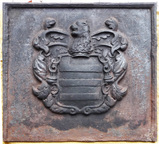-
218
Description: Rectangular; cyma recta moulded edging formed of short lengths probably derived from furniture; top left, initials arranged in triad; top right, date; top centre, rose-and-crown between two small fleurs de lys, with two concentric rope-patterned roundels outside, above two small roses; four roses evenly spaced across lower middle, with a fleur between each outer pair, and another rose below the date.
Notes: One of a series of firebacks cast between the 1670s and 1690s bearing small, simple stamps, initials and dates; the style of rose and crown is similar to that used in gun founding in the Tudor period, suggesting that the furnace that was the source of this fireback may have been used for that purpose.
Inscription: HEM [triad] 1685
- Decoration tags:
- rectangular (shape)
- complex, furniture-derived (edging)
- simple stamps
- carved stamps
- individual letters
- individual numbers
- heraldic
- royal
- text
- objects
Manufactured: in 1685 in the Weald area of England.
Current location: Brighton Museum and Art Gallery, Brighton, East Sussex, England.
Museum number: R3341/2 (part of the Brighton Museum museum group)
Citation: Gardner, J. S., 1898, 'Iron Casting in the Weald', Archaeologia, 56, 1, pp. 133-164.
Citation: Lindsay, J. S., 1927, Iron & Brass Implements of the English House (London, The Medici Society).
- Attached to series:
- 1660s-90s Wealden series
- Date & initials firebacks
-
1088
Description: Canted rectangular shape; cavetto-moulded edging (top and sides); across the top, double star stamp repeated nine times; below and top centre, date between initials in triad; below date, large hollow fleur-de-lys stamp repeated three times in a line between two triads of stylised fleur-de-lys stamps, with one of the same stamps in each bottom corner; lower centre, woodblock stamp repeated three times in a line.
Notes: The initials 'IIA' in triad probably relate to a couple whose surname initial was 'I' or 'J'; a fireback, dated 1659, with some of the same stamps is at the Dean Heritage Centre, Soudley, Gloucestershire, and another, dated 1667, has been noted at Upper End Farm, Hope Mansell, Herefordshire. Brightwells Auctioneers, Leominster, 27 Jul 2016, lot 694 (£480 inc. grate).
Inscription: IIA [triad] 1668 IIA [triad]
- Decoration tags:
- rectangular with canted top corners (shape)
- cavetto (edging)
- carved stamps
- individual letters
- individual numbers
- heraldic
- text
Manufactured: in 1668 in the Forest of Dean area of England.
Current location: not known.
- Attached to series:
- Hollow fleur Dean series
- Newent area group
- Date & initials firebacks
-
1029
Description: Arched rectangular shape; cavetto-moulded edging; shield, supporters, earl's coronet and motto scroll.
Notes: The arms are of the Hyde family: azure, a chevron between three lozenges or; the supporters: two eagles, wings endorsed sable, ducally crowned and charged on the breast with a cross or; Edward Hyde (1609-74) was created earl of Clarendon in 1661. An excrescence over the sinister supporter indicates where the iron was poured clumsily into the open sand mould.
Arms: Hyde, earls of Clarendon
- Decoration tags:
- rectangular with round arch (shape)
- cavetto (edging)
- whole carved pattern
- heraldic
- armorial
Manufactured: in the mid- to late-17th century in England.
Current location: The Lygon Arms, High Street, Broadway, Worcestershire, England.
- Attached to series:
- Personal armorial firebacks
-
1262
Description: Arched rectangular shape; ‘egg and dart’ ovolo moulding visible on top and sides; shield, helmet, crest, mantling and supporters of the Mohun family; above the crest, the initials 'EM'; date separated by the crest.
Notes: Cast from a finely carved pattern, the supporters denote these are the arms of a peer. The crest is: Gules, a maunch ermine, with a hand proper holding a fleur de lys or. An incomplete casting (without the initials or date) from Sidney Farm, Alfold, Surrey, is in Guildford Museum. Reginald Mohun (pron. Moon) of Dedisham, Slinfold, Sussex, married Elizabeth Blounte of Dedisham at Slinfold 21 Dec 1618. The Mohun barony of Okehampton, Devon was created in 1628. The fireback design probably dates from after that, the initials and date being added when this copy was cast in 1676. Bellmans auction, Wisborough Green, 1 Oct 2020 lot 3084 (£45).
Copies of this fireback are known.
Inscription: EM / 16 76 / [indecipherable motto]
Arms: Mohun family, barons of Okehampton
- Decoration tags:
- rectangular with round arch (shape)
- ovolo, egg and dart (edging)
- carved stamps
- whole carved pattern
- heraldic
- armorial
- text
Manufactured: in 1676 in England.
Current location: in private hands, Bromyard, Herefordshire, England.
- Attached to series:
- Personal armorial firebacks
- Mohun series
-
1247
Description: Low-arched shape with bevelled edging (top and sides); in each top corner, capital letter 'P' below a stylised earl's coronet, the serif at the foot of the P facing outwards on each side of the fireback.
Notes: Evidently intended to relate to the property of, or commemorating, an earl; the earldom in question has not been identified.
Inscription: P P
- Decoration tags:
- rounded arched (shape)
- bevelled (edging)
- whole carved pattern
- heraldic
- text
Manufactured: in the 20th century in England.
Current location: in private hands, Broomfield, Somerset, England.
- Attached to series:
- Miscellaneous stamp firebacks
-
1300
Description: Rectangular shape; twisted rope edging; top centre, a lion passant on the right and a lion passant guardant sinister on the left; in each top corner, a four-petalled Tudor rose; below each rose, two 'imps', one with right arm raised, the other with both arms lowered, the pair on the left facing to the right and the pair on the right facing to the left; below each lion, a crowned, four-petalled Tudor rose.
Notes: A fireback with a combination of stamps seen on a series of backs probably first produced during the reign of Henry VIII
- Decoration tags:
- rectangular (shape)
- rope (edging)
- carved stamps
- heraldic
- animals
- humans
- plants
Manufactured: in the mid-16th century in the Weald area of England.
Current location: Bunratty Castle, Bunratty, County Clare, Republic of Ireland.
- Attached to series:
- Royal series
-
202
Description: Rectangular; edging formed from furniture moulding; shield of Ayloffe impaling Sulyard impressed weakly seven times (2-3-2), with the same shield impressed eight times (3-2-3), more deeply, in the spaces between the first shields.
Notes: William Ayloffe (c1535-1584) of Bretons, Hornchurch, Essex, Justice of the Court of Queen’s Bench, married (c1560) Jane, dau. of Sir Eustace Sulyard, of Runwell, Essex. A large number of variants use the same shields. Several copies are known of this fireback, but in precisely the same arrangement, all poorly cast, unlike the variants without the additional shields, which are found in many different arrangements, some with dates and initials. From an illustration in the catalogue of an exhibition on heraldry at Burlington House, London, in 1894, it then being at Manor Farm, Edenbridge, Kent.
Copies of this fireback are known.
Arms: Ayloffe impaling Sulyard (William Ayloffe of Bretons, Hornchurch)
- Decoration tags:
- rectangular (shape)
- complex, furniture-derived (edging)
- carved stamps
- heraldic
- armorial
Manufactured: in the early-17th century in the Weald area of England.
Current location: not known.
- Attached to series:
- Ayloffe series
- Personal armorial firebacks
-
24
Description: Arched rectangular shaped with fillet and cavetto dentil moulding, and paternost bead edging inside; a lion rampant
Notes: Whole pattern. An unusually tall fireback in relation to its width.
Copies of this fireback are known.
- Decoration tags:
- rectangular with round arch (shape)
- cavetto dentil (edging)
- whole carved pattern
- heraldic
- animals
Manufactured: in the 18th century in England.
Current location: Bateman's, Burwash, East Sussex, England.
Museum number: 761107 (part of the National Trust museum group)
- Attached to series:
- Miscellaneous pattern firebacks
-
826
Description: Canted rectangular shape with moulded edging (top and sides) overlain by a length of twisted rope repeated six times; central vertical line formed of twisted rope, crossed with rope upper centre, with rope laid in a diamond pattern around the cross; lower centre, two irregular v-shapes formed of rope, one on each side of the vertical; shield shaped stamp with a fleur de lys repeated twice each side, upper left and right.
Notes: The twin V arrangement may have apotropaic significance and the cross above them having a Christian symbolism; the base board appears to have had a moulded edge, with rope lengths applied over part of the moulding after the board had been pressed into the casting bed; a sketch of this fireback was made by J. Starkie Gardner c.1891 and is in his collection at the Victoria and Albert Museum, Archive of Art and Design (AAD/2014/8).
- Decoration tags:
- rectangular with canted top corners (shape)
- rope over moulding (edging)
- simple stamps
- carved stamps
- heraldic
- apotropaic
- objects
Manufactured: in the late-16th century in the Weald area of England.
Current location: in private hands, Burwash, East Sussex, England.
- Attached to series:
- Miscellaneous stamp firebacks
- Rope design firebacks
-
621
Description: Rectangular; ovolo moulded edging (top and sides); central shield, crest and mantling of the Fuller family. The date, of which the 1 is not visible, is split between the top corners of the shield and about two-thirds of the way down.
Notes: A carved armorial on a plain, edged base board; the arms of the Fullers of Brightling Park, Sussex, are: Argent, three bars and a canton gules; the crest; Out of a ducal coronet Or, a lion’s head argent. The Fullers were iron masters and gun founders in the first half of the 18th century, operating Heathfield furnace, where it is likely that this fireback was cast.
Copies of this fireback are known.
Inscription: [1] 7 / 4 7
Arms: Fuller, of Brightling, Sussex
- Decoration tags:
- rectangular (shape)
- ovolo (edging)
- carved pattern panels
- heraldic
- armorial
- text
Manufactured: in 1747 probably at Heathfield Furnace in the Weald area of England.
Current location: in private hands, Butleigh, Somerset, England.
- Attached to series:
- Ironmasters armorial series
- Personal armorial firebacks
